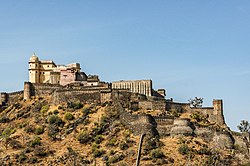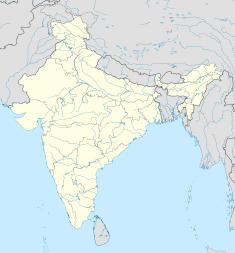
Back Крэпасць Кумбхалгарх Byelorussian কুম্ভলগড় Bengali/Bangla Khumbalgarh Catalan Kumbhalgarh Czech Kumbhalgarh German Κουμμπάλγκαρ Greek Fuerte Kumbhalgarh Spanish قلعه کومبالگار Persian Kumbhalgarh French કુંભલગઢ Gujarati
| Kumbhalgarh Fort | |
|---|---|
 Kumbhalgarh Fort in Rajsamand district (Rajasthan) | |
| Type | Fortress |
| Location | Kumbhalgarh, Rajsamand district, Rajasthan, India |
| Coordinates | 25°8′56″N 73°34′49″E / 25.14889°N 73.58028°E |
| Area | 268 ha (1.03 sq mi) (662 acres) |
| Built | 1448 A.D.[1] |
| Type | Cultural |
| Criteria | ii, iii |
| Designated | 2013 (36th session) |
| Part of | Hill Forts of Rajasthan |
| Reference no. | 247 |
| Country | |
| Region | South Asia |
Kumbhalgarh (lit. "Kumbhal fort"), also known as the Great Wall of India,[2] is a fortress on the westerly range of Aravalli Hills in Kumbhalgarh in the Rajsamand district of the Rajasthan state in India. Situated approximately 48 km (30 mi) from Rajsamand city, 84 km (52 mi) from Udaipur, it was built during the 15th century by Rana Kumbha.[3] The wall of Kumbhalgarh is one of the longest continuous walls in the world, spanning 38 kilometers.[4][5] It is also the birthplace of great king and military leader Maharana Pratap of Mewar.[6]
In 2013, at the 37th session of the World Heritage Committee held in Phnom Penh, Cambodia, Kumbhalgarh Fort, along with five other forts of Rajasthan, was declared a UNESCO World Heritage Site under the group Hill Forts of Rajasthan.[7]
- ^ Cite error: The named reference
RH1was invoked but never defined (see the help page). - ^ Pai, Sanjay A. "Kumbhalgarh, the Great Wall of India". Deccan Herald. Retrieved 18 March 2024.
- ^ "Incredible India | Kumbhalgarh". www.incredibleindia.org. Retrieved 29 October 2021.
- ^ Henbest, Nigel; Brew, Simon; Tomley, Sarah; Okona-Mensah, Ken; Parfitt, Tom; Davies, Trevor; Newkey-Burden, Chas (14 September 2023). The Colossal Book of Incredible Facts for Curious Minds: 5,000 staggering facts on science, nature, history, movies, music, the universe and more!. Octopus. ISBN 978-1-78840-470-9.
- ^ "Incredible India | Kumbhalgarh". www.incredibleindia.org. Retrieved 12 February 2024.
- ^ Mayur, Dan (12 November 2020). Global Nomad: Travels and Travails. Xlibris Corporation. ISBN 978-1-6641-3698-4.
- ^ Centre, UNESCO World Heritage. "Hill Forts of Rajasthan". UNESCO World Heritage Centre. Retrieved 10 February 2024.

